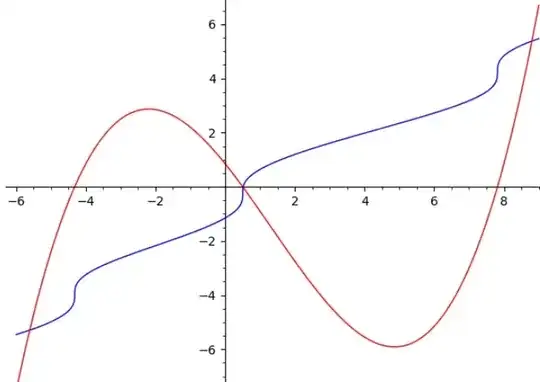I would like to say that there exists a slightly less "magic wand" solution.
Let $p(x)=x^3 - 4x^2 - 32x + 17.$
We will use later on the fact that the sum of its roots is $4$ (one of Vieta's formulas).
Let us give the names $g(x), A, B, C$ in the following expression :
$$g(x)=\underbrace{\sqrt[3]{x-a}}_A+\underbrace{\sqrt[3]{x-b}}_B+\underbrace{\sqrt[3]{x-c}}_C$$
Our hypothesis is that :
$$A+B+C=0\tag{1}$$
Now, consider classical identity (as advised by @Dave L. Renfro) :
$$A^3+B^3+C^3-3ABC=(A+B+C)\tfrac12\underbrace{((A-B)^2+(B-C)^2+(C-A)^2)}_{E}$$
Identity (1) implies
$$A^3+B^3+C^3-3ABC=0$$
Otherwise said :
$$(x-a)+(x-b)+(x-c)=3\sqrt[3]{(x-a)(x-b)(x-c)}$$
$$3x-(a+b+c)=3\sqrt[3]{p(x)}$$
$$(x-\tfrac43)^3=p(x)$$
Expanding the LHS, a big simplification occurs, leaving a first degree equation... whose root $x=\frac{523}{1008}\approx 0.51885$ is the looked-for value.
Remark : I have said upwards : "identity (1) implies" ; in fact a closer look shows that it is an "equivalence" because expression $E$ cannot be zero unless $A=B=C$ which cannot be the case.

Fig. 1 : On the same figure, a plot of functions $p$ (in fact $\frac{1}{20}p$) and $q$. Please note the inflection points of $q$ whose abscissas are the roots $\approx -4.3194676,\ \ 0.50354521,\ \ 7.8159224$ of $f$.
SAGE program for the generation of the figure (its interest is to show how the cubic root function $r3$ has to be re-defined)
var('x')
def r3(x) :
if x > 0:
y = (x)^(1/3)
else:
y = -(-x)^(1/3)
return y
#s=solve(x^3 - 4*x^2 - 32*x + 17==0,x)
def g(x) :
z = r3(x-0.50354521)+r3(x+4.3194676)+r3(x-7.8159224)
return z
G1=plot(0.05*(x^3 - 4*x^2 - 32*x + 17),-6,9,color='red');
G2=plot(g,-6,9);
G1+G2
